The Management of Irrigation and Potassium Fertilization to Mitigate the Effect of Light Frosts on the Phenolic and Volatile Compounds in Virgin Olive Oils
Abstract
1. Introduction
2. Materials and Methods
2.1. Reagents
2.2. Orchard Characteristics and Agricultural Aspects
2.3. Sample Selection and Processing
2.4. Virgin Olive Oil Extraction
2.5. Quality Physicochemical Parameters
2.6. Determination of the Phenolic Compounds
2.7. Hydrophilic ORAC Assay
2.8. Determination of the Volatile Compounds
2.9. Sensory Assessment of the Olive Oils
2.10. Statistical Analysis
3. Results and Discussion
3.1. Effect of the Ripening Stage of the Olives and Frost Phenomena on the Quality Parameters, Phenolic and Volatile Compounds, and Sensory Perception of Arbequina VOOs
3.1.1. Quality and Color Parameters
3.1.2. Phenolic Compounds
3.1.3. Antioxidant Capacity
3.1.4. Volatile Compounds
3.1.5. Sensory Analysis Results
3.2. Effect of the Agronomic Factors on the Content of Phenolic and Volatile Compounds in and the Sensory Perception of the VOOs from Fresh and Frozen Olives
3.2.1. The Effect of Irrigation and Potassium Fertilization on the Total Phenolic Compounds and Antioxidant Capacity
3.2.2. The Effect of Irrigation and Potassium Fertilization on Total Volatile Compounds
3.2.3. Effect of Irrigation and Potassium Fertilization on the Sensory Analysis Results
3.3. Multivariate Characterization of the Samples Using PCA and PLS-DA
4. Conclusions
Supplementary Materials
Author Contributions
Funding
Institutional Review Board Statement
Informed Consent Statement
Data Availability Statement
Conflicts of Interest
References
- Paleari, S. The EU Policy on Climate Change, Biodiversity and Circular Economy: Moving towards a Nexus Approach. Environ. Sci. Policy 2024, 151, 81–100. [Google Scholar] [CrossRef]
- Santibañez, F. Cambio Climático y Sector Silvoagropecuario. In Cambio Climático en Chile: Análisis de Impactos y Propuestas para Fortalecer la Mitigación y Adaptación al Cambio Climático en Sectores Relevantes; Morales, P.P., Ed.; Santiago, Chile, 2020; p. 19. ISBN 978-956-7629-48-0. [Google Scholar]
- Aro Gómez, E.M. Determinación de la Vulnerabilidad del Sector Frutícola al Cambio Climático en las Comunas de la Región de Coquimbo; Professional Title in Renewable Natural Resources Engineering, U. Chile: Santiago, Chile, 2020. [Google Scholar]
- Ministerio del Medio Ambiente. Sexto Reporte Del Estado Del Medio Ambiente, 6th ed.; Salas, B., Cohen, A., Eds.; Santiago, Chile, 2021. [Google Scholar]
- Arribillaga, D.; Bravo, R.; Campos, C.; Fuentes, M.; Gatica, J.; Luchabeche, P.; Quintana, J.; Reyes, M.; Salazar, C.; Salvo del Pedregal, J.; et al. Heladas. Factores, Tendencias y Efectos en Frutales y Vides, BOLETÍN INIA / N° 417; Bravo, R., Muñoz, M., Quintana, J., Eds.; Osorno, Chile, 2020; ISSN 0717-4829. [Google Scholar]
- García-González, D.L.; Romero, N.; Aparicio, R. Comparative Study of Virgin Olive Oil Quality from Single Varieties Cultivated in Chile and Spain. J. Agric. Food Chem. 2010, 58, 12899–12905. [Google Scholar] [CrossRef] [PubMed]
- Morelló, J.-R.; Motilva, M.-J.; Ramo, T.; Romero, M.-P. Effect of Freeze Injuries in Olive Fruit on Virgin Olive Oil Composition. Food Chem. 2003, 81, 547–553. [Google Scholar] [CrossRef]
- Fan, Z.; Lin, B.; Lin, Y.; Chen, Y.; Chen, G.; Chen, J.; Lin, H. Alleviation of Chilling Injury in Cold-Stored Chinese Olive (Canarium album Lour.) Fruit by γ-Aminobutyric Acid Treatment in Relation to ROS Metabolism. Sci. Hortic. 2024, 327, 112851. [Google Scholar] [CrossRef]
- Servili, M.; Sordini, B.; Esposto, S.; Urbani, S.; Veneziani, G.; Di Maio, I.; Selvaggini, R.; Taticchi, A. Biological Activities of Phenolic Compounds of Extra Virgin Olive Oil. Antioxidants 2014, 3, 1–23. [Google Scholar] [CrossRef]
- Fuentes, E.; Paucar, F.; Tapia, F.; Ortiz, J.; Jimenez, P.; Romero, N. Effect of the Composition of Extra Virgin Olive Oils on the Differentiation and Antioxidant Capacities of Twelve Monovarietals. Food Chem. 2018, 243, 285–294. [Google Scholar] [CrossRef]
- Ramos-Escudero, F.; Morales, M.T.; Asuero, A.G. Characterization of Bioactive Compounds from Monovarietal Virgin Olive Oils: Relationship between Phenolic Compounds-Antioxidant Capacities. Int. J. Food Prop. 2015, 18, 348–358. [Google Scholar] [CrossRef]
- Pedan, V.; Popp, M.; Rohn, S.; Nyfeler, M.; Bongartz, A. Characterization of Phenolic Compounds and Their Contribution to Sensory Properties of Olive Oil. Molecules 2019, 24, 2041. [Google Scholar] [CrossRef] [PubMed]
- da Silva, M.D.R.G.; Costa Freitas, A.M.; Cabrita, M.J.B.; Garci, R. Olive Oil Composition: Volatile Compounds. In Olive Oil—Constituents, Quality, Health Properties and Bioconversions; Dimitrios, B., Ed.; InTech: Houston, TX, USA, 2012. [Google Scholar]
- Bendini, A.; Cerretani, L.; Carrasco-Pancorbo, A.; Gómez-Caravaca, A.; Segura-Carretero, A.; Fernández-Gutiérrez, A.; Lercker, G. Phenolic Molecules in Virgin Olive Oils: A Survey of Their Sensory Properties, Health Effects, Antioxidant Activity and Analytical Methods. An Overview of the Last Decade Alessandra. Molecules 2007, 12, 1679–1719. [Google Scholar] [CrossRef]
- Morelló, J.R.; Romero, M.P.; Motilva, M.J. Influence of Seasonal Conditions on the Composition and Quality Parameters of Monovarietal Virgin Olive Oils. J. Am. Oil Chem. Soc. 2006, 83, 683–690. [Google Scholar] [CrossRef]
- Aparicio, R.; Harwood, J. Handbook of Olive Oil: Analysis and Properties, 2nd ed.; Aparicio, R., Harwood, J., Eds.; Springer: Boston, MA, USA, 2013; ISBN 9781461477778. [Google Scholar]
- Romero, I.; Aparicio-Ruiz, R.; Oliver-Pozo, C.; Aparicio, R.; García-González, D.L. Characterization of Virgin Olive Oils with Two Kinds of “Frostbitten Olives” Sensory Defect. J. Agric. Food Chem. 2016, 64, 5590–5597. [Google Scholar] [CrossRef] [PubMed]
- Pino, C.; Sepúlveda, B.; Tapia, F.; Saavedra, J.; García-González, D.L.; Romero, N. The Impact of Mild Frost Occurring at Different Harvesting Times on the Volatile and Phenolic Composition of Virgin Olive Oil. Antioxidants 2022, 11, 852. [Google Scholar] [CrossRef]
- Scalisi, A.; Marino, G.; Marra, F.P.; Caruso, T.; Lo Bianco, R. A Cultivar-Sensitive Approach for the Continuous Monitoring of Olive (Olea europaea L.) Tree Water Status by Fruit and Leaf Sensing. Front. Plant Sci. 2020, 11. [Google Scholar] [CrossRef] [PubMed]
- Mailer, R.; Ayton, J. Effect of Irrigation and Water Stress on Olive Oil Quality and Yield Based on a Four Year Study. Acta Hortic. 2011, 888, 63–72. [Google Scholar] [CrossRef]
- Romero, M.P.; Tovar, M.J.; Girona, J.; Motilva, M.J. Changes in the HPLC Phenolic Profile of Virgin Olive Oil from Young Trees (Olea europaea L. cv. Arbequina) Grown under Different Deficit Irrigation Strategies. J. Agric. Food Chem. 2002, 50, 5349–5354. [Google Scholar] [CrossRef] [PubMed]
- Saadati, S.; Baninasab, B.; Mobli, M.; Gholami, M. Foliar Application of Potassium to Improve the Freezing Tolerance of Olive Leaves by Increasing Some Osmolite Compounds and Antioxidant Activity. Sci. Hortic. 2021, 276, 109765. [Google Scholar] [CrossRef]
- Myer, R.; Montgomery, D.; Anderson-Cook, C. Response Surface Methodology: Process and Product Optimization Using Designed Experiments; John Wiley & Sons, Inc.: Hoboken, NJ, USA, 2016. [Google Scholar]
- Morales Cepeda, A.P. Influencia de la Intensidad de Poda en Olivos Variedad Coratina Sobre las Características del Aceite de Oliva; Professional Title in Agricultural Engineering, U. Chile: Santiago, Chile, 2011. [Google Scholar]
- AOCS Press. American Oil Chemists’s Society. In Official Methods and Recommended Practices of the AOCS; AOCS Press: Champaign, IL, USA, 2009. [Google Scholar]
- Caipo, L.; Sandoval, A.; Sepúlveda, B.; Fuentes, E.; Valenzuela, R.; Metherel, A.H.; Romero, N. Effect of Storage Conditions on the Quality of Arbequina Extra Virgin Olive Oil and the Impact on the Composition of Flavor-Related Compounds (Phenols and Volatiles). Foods 2021, 10, 2161. [Google Scholar] [CrossRef] [PubMed]
- International Olive Council (COI). COI/T.20/DOC.No 15/Rev.10. In Sensory Analysis of Olive Oil: Method for the Organoleptic Assessment of Virgin Olive Oil; International Olive Council: Madrid, Spain, 2018. [Google Scholar]
- Wold, S.; Sjöström, M.; Eriksson, L. PLS-Regression: A Basic Tool of Chemometrics. Chemom. Intell Lab. Syst. 2001, 58, 109–130. [Google Scholar] [CrossRef]
- Cen, H.; He, Y.; Huang, M. Combination and Comparison of Multivariate Analysis for the Identification of Orange Varieties Using Visible and Near Infrared Reflectance Spectroscopy. Eur. Food Res. Technol. 2007, 225, 699–705. [Google Scholar] [CrossRef]
- National Institute of Standards and Technology. Statistical Engineering Division Data Plot: GRUBBS TEST. Available online: https://www.itl.nist.gov/div898/software/dataplot/refman1/auxillar/grubtest.htm (accessed on 20 December 2023).
- Rincón, L. Curso Intermedio de Probabilidad, 1st ed. Available online: https://www.matematicas.unam.mx/lars (accessed on 24 January 2024).
- Masella, P.; Guerrini, L.; Angeloni, G.; Spadi, A.; Baldi, F.; Parenti, A. Freezing/Storing Olives, Consequences for Extra Virgin Olive Oil Quality. Int. J. Refrig. 2019, 106, 24–32. [Google Scholar] [CrossRef]
- Mele, M.A.; Islam, M.Z.; Kang, H.M.; Giuffrè, A.M. Pre-and Post-Harvest Factors and their Impact on Oil Composition and Quality of Olive Fruit. Emir. J. Food Agric. 2018, 30, 592–603. [Google Scholar] [CrossRef]
- Rallo, L.; Díez, C.M.; Morales-Sillero, A.; Miho, H.; Priego-Capote, F.; Rallo, P. Quality of Olives: A Focus on Agricultural Preharvest Factors. Sci. Hortic. 2018, 233, 491–509. [Google Scholar] [CrossRef]
- Shahidi, F.; Zhong, Y. Measurement of antioxidant activity. J. Funct. Foods 2015, 18, 757–781. [Google Scholar] [CrossRef]
- Carrasco-Pancorbo, A.; Cerretani, L.; Bendini, A.; Segura-Carretero, A.; Del Carlo, M.; Gallina-Toschi, T.; Lercker, G.; Compagnone, D.; Fernandez-Gutierrez, A. Evaluation of the antioxidant capacity of individual phenolic compounds in virgin olive oil. J. Agric. Food Chem. 2005, 53, 8918–8925. [Google Scholar] [CrossRef] [PubMed]
- Wang, Y.; Yu, L.; Zhao, A.; Karrar, E.; Zhang, H.; Jin, Q.; Wang, X. Quality characteristics and antioxidant activity during fruit ripening of three monovarietal olive oils cultivated in China. J. Am. Oil Chem. Soc. 2021, 98, 229–240. [Google Scholar] [CrossRef]
- Servili, M.; Selvaggini, R.; Esposto, S.; Taticchi, A.; Montedoro, G.; Morozzi, G. Health and sensory properties of virgin olive oil hydrophilic phenols: Agronomic and technological aspects of production that affect their occurrence in the oil. J. Chromatog. A 2004, 1054, 113–127. [Google Scholar] [CrossRef]
- Hachicha Hbaieb, R.; Kotti, F.; Cortes-Francisco, N.; Caixach, J.; Gargouri, M.; Vichi, S. Ripening and Storage Conditions of Chétoui and Arbequina Olives: Part II. Effect on Olive Endogenous Enzymes and Virgin Olive Oil Secoiridoid Profile Determined by High Resolution Mass Spectrometry. Food Chem. 2016, 210, 631–639. [Google Scholar] [CrossRef] [PubMed]
- García-Vico, L.; García-Rodríguez, R.; Sanz, C.; Pérez, A.G. Biochemical Aspects of Olive Freezing-Damage: Impact on the Phenolic and Volatile Profiles of Virgin Olive Oil. LWT 2017, 86, 240–246. [Google Scholar] [CrossRef]
- Tapia, C.F.; Salas, F.C.; Riveros, B.F.; Abarca, R.P. Manual de Manejo de Huerto de Olivo. Boletín INIA/N°381; Quiroz, E.C., Gonzaléz, V.É., Eds.; Instituto de Investigaciones Agropecuarias: Santiago, Chile, 2017. [Google Scholar]
- Brkić Bubola, K.; Lukić, M.; Novoselić, A.; Krapac, M.; Lukić, I. Olive Fruit Refrigeration during Prolonged Storage Preserves the Quality of Virgin Olive Oil Extracted Therefrom. Foods 2020, 9, 1445. [Google Scholar] [CrossRef]
- Guillaume, C.; Ravetti, L.; Gwyn, S. Characterisation of Phenolic Compounds in Oils Produced from Frosted Olives. J. Am. Oil Chem. Soc. 2010, 87, 247–254. [Google Scholar] [CrossRef]
- Romero, N.; Saavedra, J.; Tapia, F.; Sepúlveda, B.; Aparicio, R. Influence of Agroclimatic Parameters on Phenolic and Volatile Compounds of Chilean Virgin Olive Oils and Characterization Based on Geographical Origin, Cultivar and Ripening Stage. J. Sci. Food Agric. 2016, 96, 583–592. [Google Scholar] [CrossRef] [PubMed]
- García, J.M.; Morales-Sillero, A.; Pérez-Rubio, A.G.; Diaz-Espejo, A.; Montero, A.; Fernández, J.E. Virgin Olive Oil Quality of Hedgerow ‘Arbequina’ Olive Trees under Deficit Irrigation. J. Sci. Food Agric. 2017, 97, 1018–1026. [Google Scholar] [CrossRef] [PubMed]
- Tovar, M.J.; Romero, M.P.; Girona, J.; Motilva, M.J. Phenylalanine Ammonia-lyase Activity and Concentration of Phenolics in Developing Olive (Olea europaea L Cv Arbequina) Fruit Grown under Different Irrigation Regimes. J. Sci. Food Agric. 2002, 82, 892–898. [Google Scholar] [CrossRef]
- Sastre, B.; Arbonés, A.; Benito, A.; Rufat, J.; de Lorenzo, C.; Pacual, M.; Villar, J.; Pérez, M.Á. Efecto del Riego Deficitario en un Superintensivo de Arbequina sobre la calidad del Aceite de Oliva Virgen. Sci. Hortic. 2014, 169, 71–93. [Google Scholar] [CrossRef]
- Tognetti, R.; D’Andria, R.; Sacchi, R.; Lavini, A.; Morelli, G.; Alvino, A. Deficit Irrigation Affects Seasonal Changes in Leaf Physiology and Oil Quality of Olea Europaea (Cultivars Frantoio and Leccino). Ann. Appl. Biol. 2007, 150, 169–186. [Google Scholar] [CrossRef]
- García, J.M.; Hueso, A.; Gómez-del- Campo, M. Deficit Irrigation during the Oil Synthesis Period Affects Olive Oil Quality in High-Density Orchards (Cv. Arbequina). Agric. Water Manag. 2020, 230, 105858. [Google Scholar] [CrossRef]
- Tekaya, M.; Mechri, B.; Bchir, A.; Attia, F.; Cheheb, H.; Daassa, M.; Hammami, M. Enhancement of Antioxidants in Olive Oil by Foliar Fertilization of Olive Trees. J. Am. Oil Chem. Soc. 2013, 90, 1377–1386. [Google Scholar] [CrossRef]
- Pascual, M.; Villar, J.M.; Arbones, A.; Rufat, J. Nitrogen Nutrition Diagnosis for Olive Trees Grown in Super-Intensive Cropping Systems. J. Plant Nutr. 2019, 42, 1803–1817. [Google Scholar] [CrossRef]
- Tognetti, R.; Morales-Sillero, A.; D’Andria, R.; Fernández, J.E.; Lavini, A.; Sebastiani, L.; Troncoso, A. Deficit Irrigation and Fertigation Practices in Olive Growing: Convergences and Divergences in Two Case Studies. Plant Biosyst. 2008, 142, 138–148. [Google Scholar] [CrossRef]
- Li, W.; He, P.; Jin, J. Potassium Influenced Phenylalanine Ammonia-Lyase, Peroxidases and Polyphenol Oxidases in Fusarium graminearum Infected maize (Zea mays L.). Available online: https://escholarship.org/uc/item/3cf201nb (accessed on 10 November 2023).
- Arbonés, A.; Rufat, J.; Pérez, M.A.; Pascual, M.; Benito, A.; De Lorenzo, C.; Villar, J.M.; Sastre, B. The Influence of Olive Tree Fertilization on the Phenols in Virgin Olive Oils. A Review. Grasas y Aceites 2022, 73, e470. [Google Scholar] [CrossRef]
- Dabbaghi, O.; Tekaya, M.; Flamini, G.; Zouari, I.; El-Gharbi, S.; M’barki, N.; Laabidi, F.; Cheheb, H.; Attia, F.; Aïachi Mezghani, M.; et al. Modification of Phenolic Compounds and Volatile Profiles of Chemlali Variety Olive Oil in Response to Foliar Biofertilization. J. Am. Oil Chem. Soc. 2019, 96, 585–593. [Google Scholar] [CrossRef]
- Fernandes-Silva, A.A.; Falco, V.; Correia, C.M.; Villalobos, F.J. Sensory Analysis and Volatile Compounds of Olive Oil (Cv. Cobrançosa) from Different Irrigation Regimes. Grasas y Aceites 2013, 64, 59–67. [Google Scholar] [CrossRef]
- Dabbou, S.; Brahmi, F.; Selvaggini, R.; Chehab, H.; Dabbou, S.; Taticchi, A.; Servili, M.; Hammami, M. Contribution of Irrigation and Cultivars to Volatile Profile and Sensory Attributes of Selected Virgin Olive Oils Produced in Tunisia. Int. J. Food Sci. Technol. 2011, 46, 1964–1976. [Google Scholar] [CrossRef]
- García-Garví, J.M.; Sánchez-Bravo, P.; Hernández, F.; Sendra, E.; Corell, M.; Moriana, A.; Burgos-Hernández, A.; Carbonell-Barrachina, Á.A. Effect of Regulated Deficit Irrigation on the Quality of ‘Arbequina’ Extra Virgin Olive Oil Produced on a Super-High-Intensive Orchard. Agronomy 2022, 12, 1892. [Google Scholar] [CrossRef]
- Wang, Z.M.; Lu, Z.M.; Shi, J.S.; Xu, Z.H. Exploring Flavour-Producing Core Microbiota in Multispecies Solid-State Fermentation of Traditional Chinese Vinegar. Sci. Rep. 2016, 6. [Google Scholar] [CrossRef]
- Romero, I.; García-González, D.L.; Aparicio-Ruiz, R.; Morales, M.T. Study of Volatile Compounds of Virgin Olive Oils with “Frostbitten Olives” Sensory Defect. J. Agric. Food Chem. 2017, 65, 4314–4320. [Google Scholar] [CrossRef]
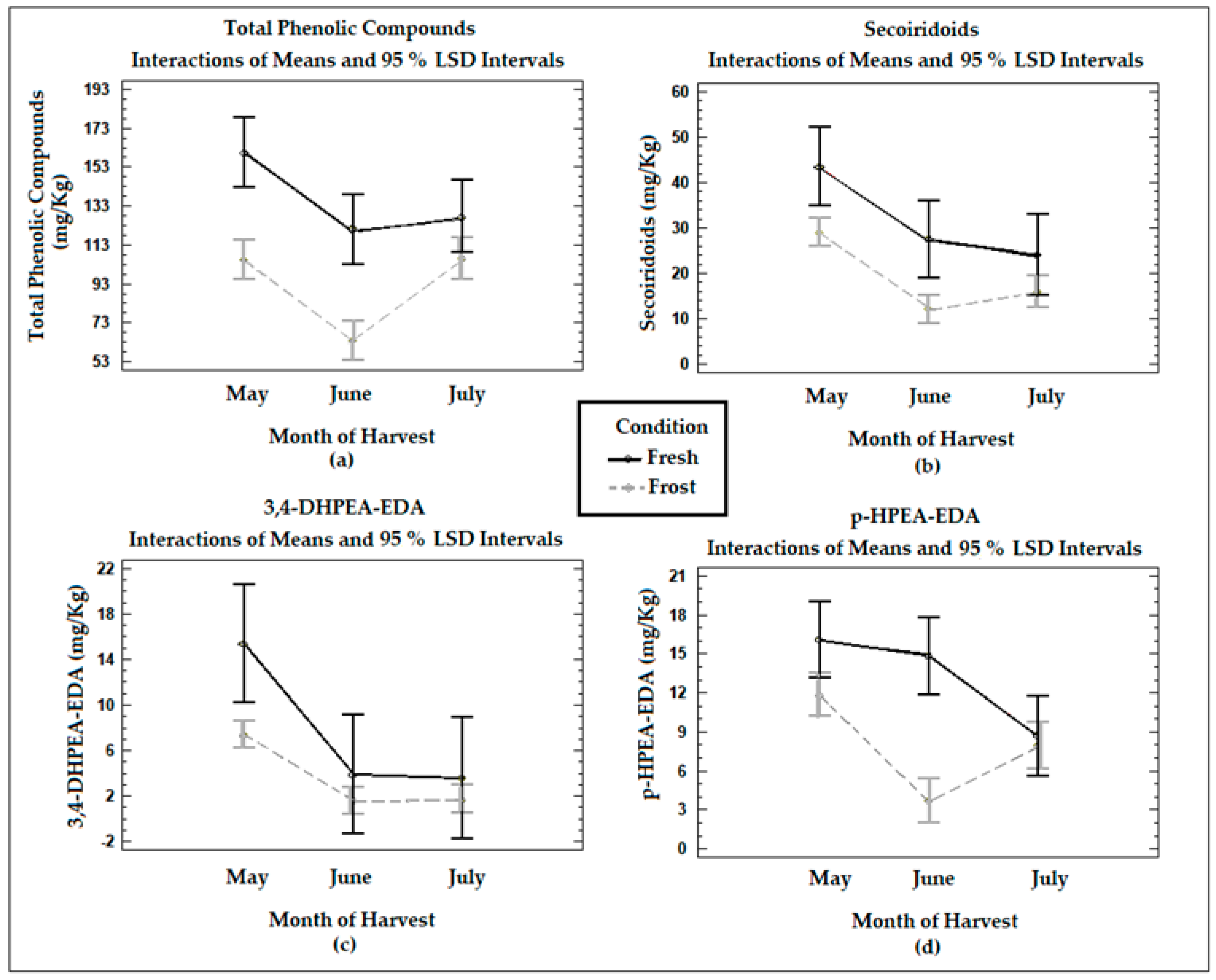
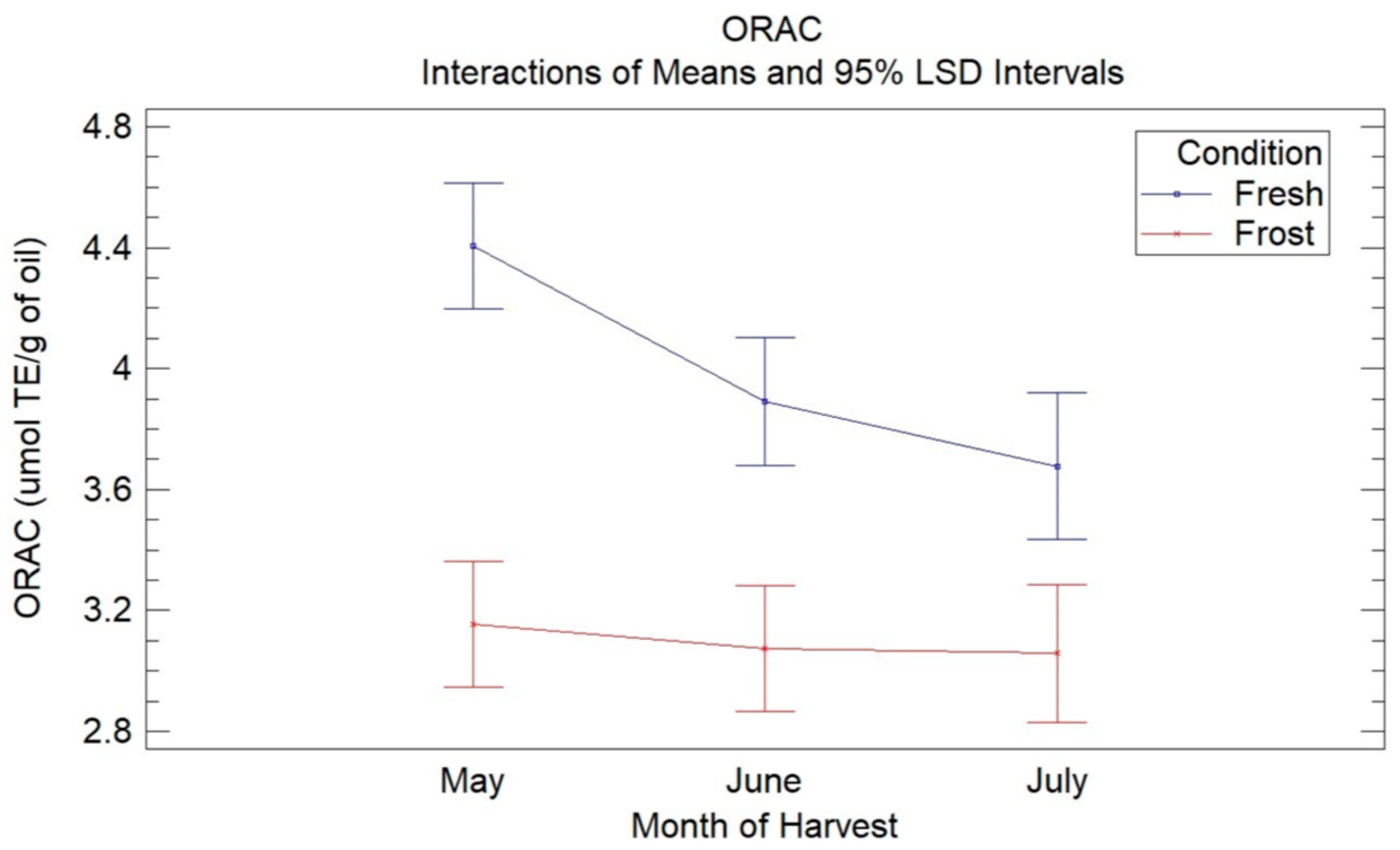

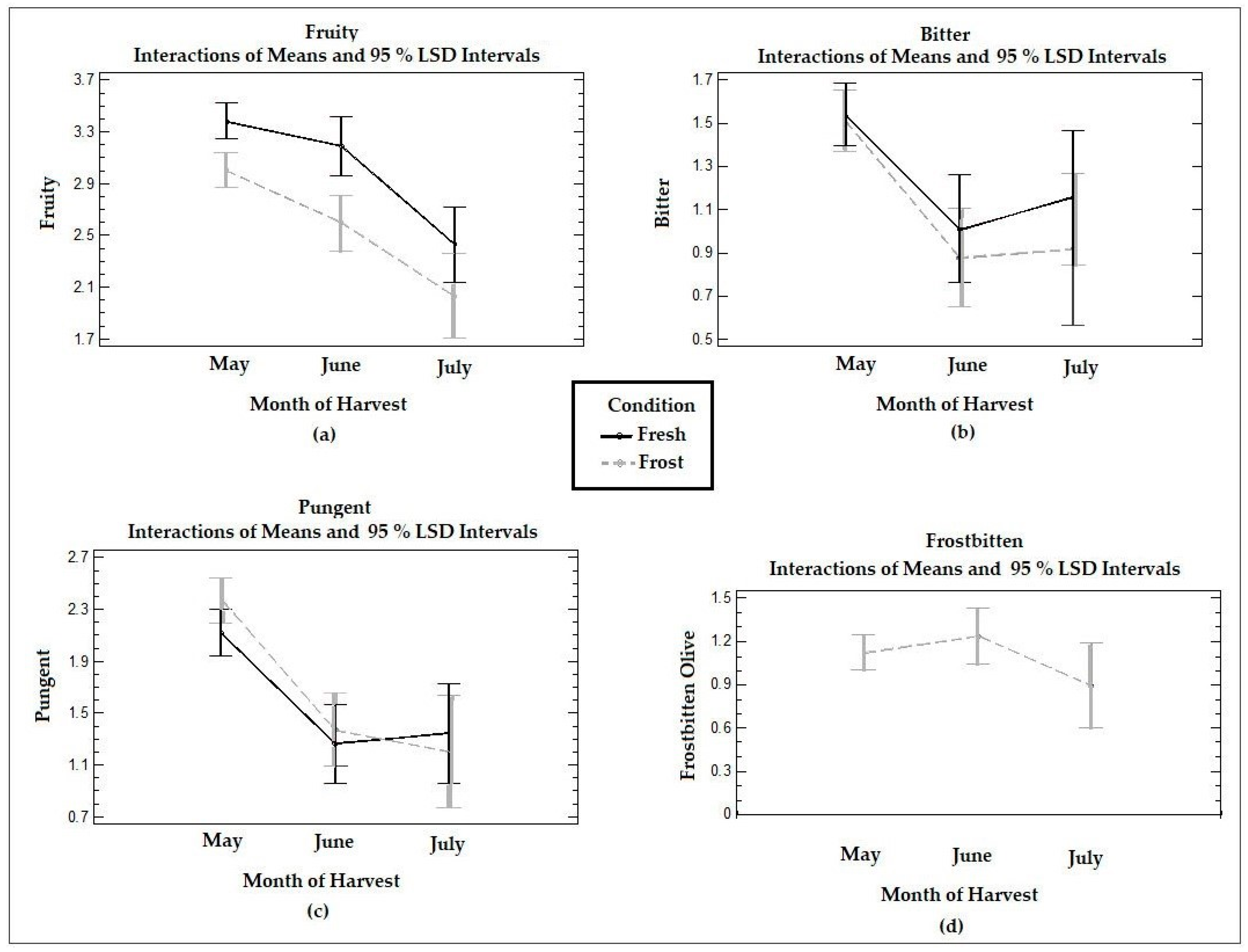
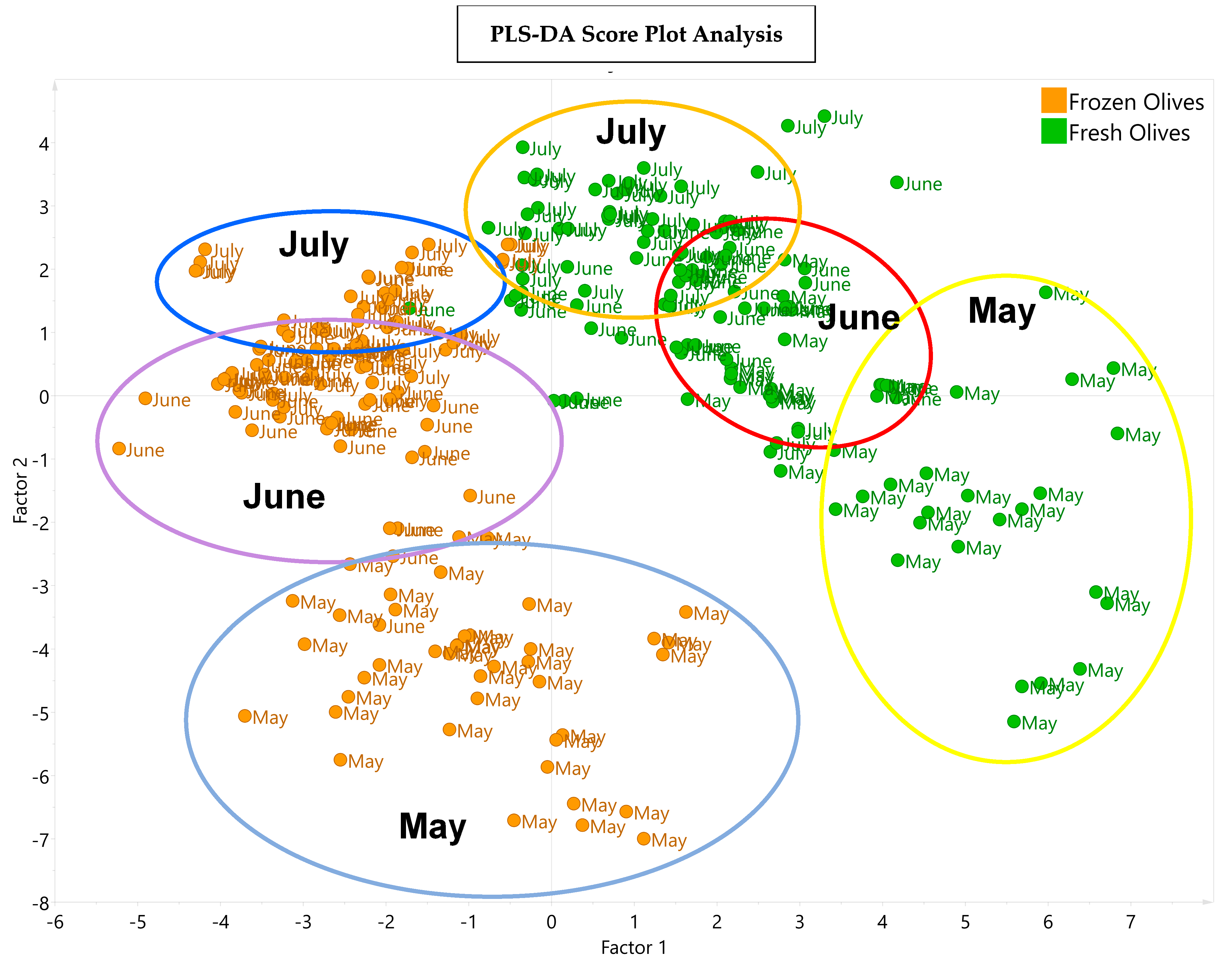

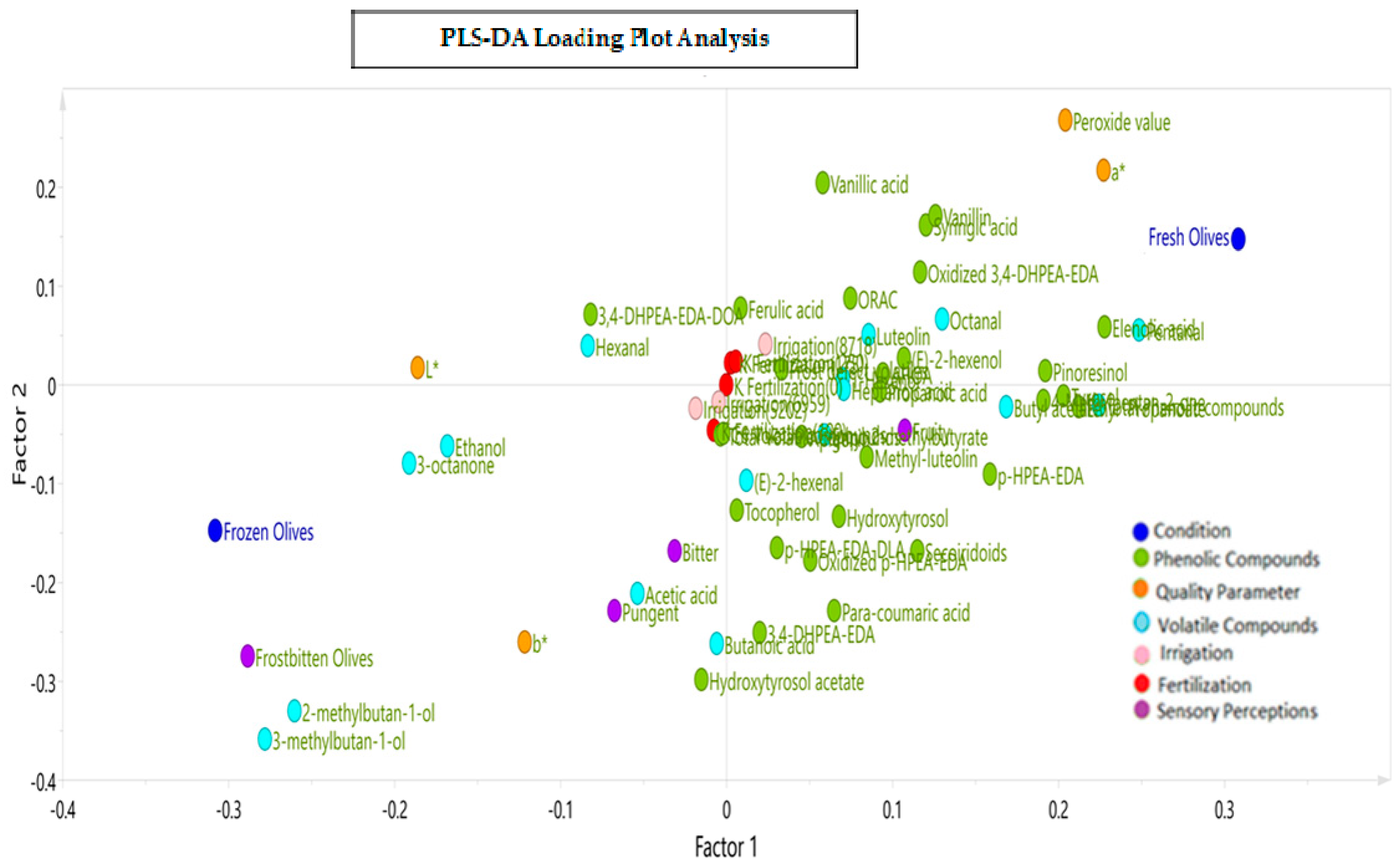
| Box–Behnken Sample | Irrigation (% ET0) | Potassium Fertilization (UK2O) | Copper Oxychloride (g/100 L of Water) |
|---|---|---|---|
| 1 | 75 | 100 | 200 |
| 2 | 125 | 100 | 200 |
| 3 | 75 | 250 | 200 |
| 4 | 125 | 250 | 200 |
| 5 | 75 | 175 | 100 |
| 6 | 125 | 175 | 100 |
| 7 | 75 | 175 | 300 |
| 8 | 125 | 175 | 300 |
| 9 | 100 | 100 | 100 |
| 10 | 100 | 250 | 100 |
| 11 | 100 | 100 | 300 |
| 12 | 100 | 250 | 300 |
| 13 | 100 | 175 | 200 |
| 14 | 100 | 175 | 200 |
| 15 | 100 | 175 | 200 |
| Condition | May | June | July | |
|---|---|---|---|---|
| Free fatty acids (% of oleic acid) | Fresh | 0.12 aA ± 0.01 | 0.10 aA ± 0.01 | 0.15 bA ± 0.01 |
| Frost | 0.15 bB ± 0.01 | 0.16 bB ± 0.01 | 0.17 bcB ± 0.01 | |
| Peroxide value (mEq O2/kg of oil) | Fresh | 3.79 cA ± 0.27 | 4.20 cA ± 0.27 | 3.78 cA ± 0.29 |
| Frost | 1.96 aB ± 0.13 | 3.22 bB ± 0.14 | 3.30 bB ± 0.15 | |
| K232 | Fresh | 2.06 bA ± 0.04 | 2.06 bB ± 0.04 | 2.22 cA ± 0.04 |
| Frost | 1.87 aB ± 0.04 | 2.18 cA ± 0.04 | 2.14 bcB ± 0.04 | |
| K270 | Fresh | 0.09 bA ± 0.00 | 0.09 bA ± 0.00 | 0.08 aA ± 0.00 |
| Frost | 0.08 aB ± 0.00 | 0.09 bA ± 0.00 | 0.08 aA ± 0.00 | |
| L * | Fresh | 86.9 aA ± 3.46 | 91.28 abA ± 3.46 | 97.65 bcA ± 3.58 |
| Frost | 98.74 cB ± 1.19 | 99.51 cB ± 1.19 | 98.41 cA ± 1.28 | |
| a * | Fresh | −7.77 aA ± 0.65 | −8.17 aA ± 0.65 | −7.60 aA ± 0.67 |
| Frost | −11.09 cB ± 0.40 | −9.32 bB ± 0.40 | −9.67 bB ± 0.43 | |
| b * | Fresh | 34.61 bA ± 1.74 | 30.64 aA ± 1.74 | 28.06 aA ± 1.80 |
| Frost | 38.47 bcB ± 1.68 | 29.80 aA ± 1.48 | 34.87 bB ± 1.59 |
| Total Phenolic Compounds | ||||||
|---|---|---|---|---|---|---|
| Month of Harvest | Condition | Optimal Irrigation (% ET0) | Optimal Potassium Fertilization (UK2O or kg/ha) | Optimal Phenolic Concentration (mg/kg) | R2adj% * | MAE ** |
| May | Fresh | 75 | 250 | 251 | 75.97% | 10.35 |
| Frost | 86 | 100 | 154 | 85.31% | 3.41 | |
| June | Fresh | 125 | 100 | 188 | 85.99% | 5.20 |
| Frost | 125 | 100 | 111 | 83.92% | 3.67 | |
| July | Fresh | 125 | 100 | 232 | 88.55% | 6.60 |
| Frost | 110 | 107 | 156 | 87.45% | 4.93 | |
| RAC Assay | ||||||
| Month of Harvest | Condition | Optimal Irrigation (% ET0) | Optimal Potassium Fertilization (UK2O or kg/ha) | Optimal ORAC Value (µmol TE/g) | R2adj% * | MAE ** |
| May | Fresh | 75 | 250 | 5.58 | 83.56 | 0.1702 |
| Frost | 125 | 100 | 4.57 | 88.32 | 0.0830 | |
| Total Volatile Compounds | ||||||
|---|---|---|---|---|---|---|
| Month of Harvest | Condition | Optimal Irrigation (% ET0) | Optimal Potassium Fertilization (UK2O) | Volatile Concentration (mg/kg) | R2adj% * | MAE ** |
| May | Fresh | 121 | 131 | 91 | 90.80 | 1.96 |
| Frost | 125 | 117 | 72 | 71.98 | 0.96 | |
| June | Fresh | 125 | 250 | 76 | 76.34 | 1.90 |
| Frost | 125 | 250 | 75 | 74.98 | 1.57 | |
| July | Fresh | 99 | 130 | 63 | 63.31 | 0.83 |
| Frost | 103 | 250 | 72 | 72.27 | 1.88 | |
| Sensory Attributes for the Month of May | ||||||
|---|---|---|---|---|---|---|
| Descriptor | Condition | Optimal Irrigation (% ET0) | Optimal Potassium Fertilization (UK2O) | Optimal Sensory Attributes (Means) | R2adj% * | MAE ** |
| Fruity | Fresh | 75 | 250 | 4.6 | 62.16 | 0.34 |
| Frost | 75 | 100 | 3.0 | 57.08 | 0.12 | |
| Pungency | Fresh *** | - | - | - | - | - |
| Frost | 75 | 204 | 3.4 | 62.64 | 0.45 | |
| Bitter | Fresh | 75 | 250 | 3.0 | 59.64 | 0.34 |
| Frost | 75 | 100 | 2.3 | 64.50 | 0.11 | |
Disclaimer/Publisher’s Note: The statements, opinions and data contained in all publications are solely those of the individual author(s) and contributor(s) and not of MDPI and/or the editor(s). MDPI and/or the editor(s) disclaim responsibility for any injury to people or property resulting from any ideas, methods, instructions or products referred to in the content. |
© 2024 by the authors. Licensee MDPI, Basel, Switzerland. This article is an open access article distributed under the terms and conditions of the Creative Commons Attribution (CC BY) license (https://creativecommons.org/licenses/by/4.0/).
Share and Cite
Antonelli, S.; Pozas, S.; Saavedra-Torrico, J.; Donders, M.; Bustamante, C.; Sepúlveda, B.; Tapia, F.; García-González, D.L.; Romero, N. The Management of Irrigation and Potassium Fertilization to Mitigate the Effect of Light Frosts on the Phenolic and Volatile Compounds in Virgin Olive Oils. Antioxidants 2024, 13, 559. https://doi.org/10.3390/antiox13050559
Antonelli S, Pozas S, Saavedra-Torrico J, Donders M, Bustamante C, Sepúlveda B, Tapia F, García-González DL, Romero N. The Management of Irrigation and Potassium Fertilization to Mitigate the Effect of Light Frosts on the Phenolic and Volatile Compounds in Virgin Olive Oils. Antioxidants. 2024; 13(5):559. https://doi.org/10.3390/antiox13050559
Chicago/Turabian StyleAntonelli, Suony, Sebastián Pozas, Jorge Saavedra-Torrico, Mauricio Donders, Chris Bustamante, Betsabet Sepúlveda, Francisco Tapia, Diego L. García-González, and Nalda Romero. 2024. "The Management of Irrigation and Potassium Fertilization to Mitigate the Effect of Light Frosts on the Phenolic and Volatile Compounds in Virgin Olive Oils" Antioxidants 13, no. 5: 559. https://doi.org/10.3390/antiox13050559
APA StyleAntonelli, S., Pozas, S., Saavedra-Torrico, J., Donders, M., Bustamante, C., Sepúlveda, B., Tapia, F., García-González, D. L., & Romero, N. (2024). The Management of Irrigation and Potassium Fertilization to Mitigate the Effect of Light Frosts on the Phenolic and Volatile Compounds in Virgin Olive Oils. Antioxidants, 13(5), 559. https://doi.org/10.3390/antiox13050559









